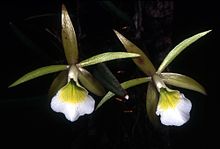Brassavola
| Brassavola | ||||||||||||
|---|---|---|---|---|---|---|---|---|---|---|---|---|

Brassavola flagellaris |
||||||||||||
| Systematics | ||||||||||||
|
||||||||||||
| Scientific name | ||||||||||||
| Brassavola | ||||||||||||
| R.Br. |
The genus Brassavola from the family of the orchid (Orchidaceae) consists of 24 species , all in Central and South America occur. The plants usually grow epiphytically or on rocks. They are occasionally cultivated because of their beautiful flowers .
description
All species of this genus form sprouts at a short distance from a creeping rhizome . These are short and not thickened, they consist of several internodes . The rhizome and shoot are surrounded by membranous, dry lower leaves. At the tip of the pseudobulbs there is one, rarely two leaves . The leaves are long, fleshy and round in cross-section with a groove on top. The shoot and leaves grow upright or hang over.
The inflorescence appears from a small sheathed leaf at the tip of the shoot. Depending on the species, it only bears one or more flowers. The resupinated flowers are always whitish in color. The sepals and petals are almost the same shape: narrow and pointed at the end, light green or light yellow in color, the three outer petals are sometimes purple or spotted on the outside. The white lip is unlapped, at the base the sides are curled up tightly around the column . At the base the lip is sometimes speckled purple, in the middle with a yellow or green spot, at the front it ends in a point (long thread-like drawn out in Brassavola cucullata ). The edge of the lip can be smooth, wavy, rough or noticeably fringed. The column is short and straight, mostly winged. The stamen sits at the end of the column and is surrounded by a three-lobed cap (clinandrium), it contains eight pollinia .
Between the ovary and the attachment point of the petals there is an elongated "neck" (cuniculus). Here the flower forms a deep, narrow nectarium . This part of the flower also sticks to the fruit until it is ripe. The species smell at night and attract nocturnal swarmers (Sphingidae) with it and the nectar offered . The pollinia are glued to the proboscis while the insect tries to reach the nectar.
distribution
The species of the genus Brassavola occur from Mexico across Central America and the Caribbean to South America. The southernmost occurrences are still found in Argentina and Paraguay. They grow there as epiphytes at low altitudes.
Systematics
Within the subfamily Epidendroideae , the genus Brassavola is classified in the tribe Epidendreae and there in the subtribe Laeliinae . Brassavola is closely related to Cattleya , Cattleyella , Guarianthe and Rhyncholaelia .
The following 24 species have been described in this genus:
- Brassavola acaulis Lindl. & Paxton , Central America.
- Brassavola angustata Lindl. , Trinidad-Tobago, northern South America to Brazil.
- Brassavola appendiculata A. Rich. & Galeotti , southern Mexico to Nicaragua.
- Brassavola ceboletta Rchb.f. , Peru to Brazil and northeast Argentina.
- Brassavola cucullata (L.) R.Br. in WTAiton , from Mexico south through Central America to northern South America and on some Caribbean islands.
- Brassavola fasciculata Pabst , Brazil.
- Brassavola filifolia Linden , Colombia.
- Brassavola flagellaris Barb. Rodr. , Brazil.
- Brassavola gardneri cogn. , French Guiana to Brazil.
- Brassavola gillettei H.G.Jones , Trinidad.
- Brassavola grandiflora Lindl. , from Belize south through Central America to Colombia.
- Brassavola harrisii H.G. Jones , Jamaica.
- Brassavola martiana Lindl. (Syn .: Brassavola duckeana Horta ), northern South America.
- Brassavola nodosa (L.) Lindl. , from Mexico south through Central America to northern South America and on some Caribbean islands.
- Brassavola perrinii Lindl. , Bolivia to northeast Argentina.
- Brassavola pitengoensis Campacci , Minas Gerais .
- Brassavola reginae Lindl. , Venezuela and Peru, maybe also northern Brazil.
- Brassavola revoluta Barb. Rodr. , Brazil.
- Brassavola rhomboglossa Pabst , Brazil.
- Brassavola subulifolia Lindl. , Jamaica.
- Brassavola tuberculata Hook. (Syn .: Brassavola fragans Barb. Rodr. ), Brazil, Peru, Bolivia, northern Argentina and Paraguay.
- Brassavola venosa Lindl. , southern Mexico to Nicaragua.
- Brassavola xerophylla Archila , Guatemala.
Culture
Because of the large, fragrant flowers, the plants can be found in culture. Compared to other orchids, they make less demands on the cultivation conditions. They were often used as crossbreeding partners.
Name declaration
Robert Brown named the genus in 1813 after the botanist Antonio Musa Brassavola (1500–1554) from Ferrara . This assumption is likely, but not entirely certain.
literature
- CH Dodson, CA Luer (2005): Orchidaceae part 2 (Aa-Cyrtidiorchis) . In: G. Harling, L. Andersson (Eds.): Flora of Ecuador . Vol. 76, p. 127ff. Botanical Institute, Göteborg University, ISBN 91-88896-51-X
- Carl L. Withner (1998): The Cattleyas and their relatives . Vol. 5, p. 31ff. Timber Press, Portland, Oregon ISBN 0-88192-456-3
Individual evidence
- ^ Cássio van den Berg et al. (2000): A phylogenetic analysis of Laeliinae (Orchidaceae) based on sequence data from internal transcribed spacers (ITS) of nuclear ribosomal DNA. Lindleyana 15 (2): 96-114. Online, accessed on December 14, 2007 ( Memento of the original from September 26, 2007 in the Internet Archive ) Info: The archive link was inserted automatically and has not yet been checked. Please check the original and archive link according to the instructions and then remove this notice.
- ↑ a b c d e f g h i j k l m n o p q r s t u v w x Rafaël Govaerts (Ed.): Brassavola. In: World Checklist of Selected Plant Families (WCSP) - The Board of Trustees of the Royal Botanic Gardens, Kew . Retrieved April 6, 2020.
- ↑ Lotte Burkhardt: Directory of eponymous plant names . Extended Edition. Botanic Garden and Botanical Museum Berlin, Free University Berlin Berlin 2018. [1]




